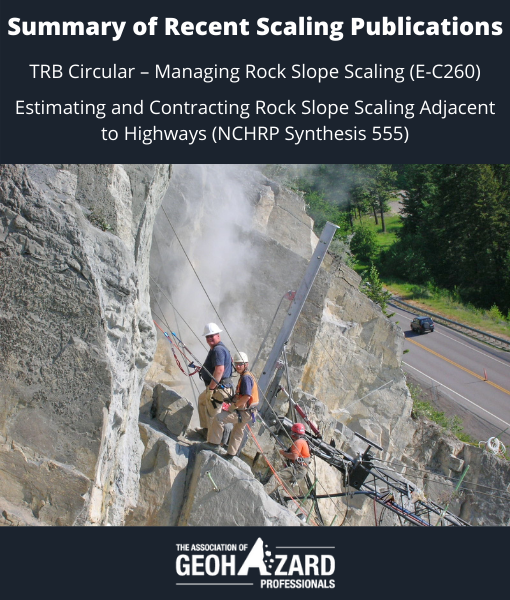View this webinar on-demand by logging into the Member Center. If you are not a member, we encourage you to join.
Summary of Recent Scaling Publications
TRB Circular – Managing Rock Slope Scaling (E-C260) and Estimating and Contracting Rock Slope Scaling Adjacent to Highways (NCHRP Synthesis 555)
Scaling loose rocks from slopes adjacent to highways is a simple and effective measure for temporarily reducing the risk of rockfall potential on naturally occurring bedrock outcrops and highway rock–soil cuts. As defined in Rockfall: Characterization and Control, “scaling is a form of excavation used principally to remove individual loose or unstable rock blocks from a slope face.” Removal typically is done by hand using pry bars or with mechanical assistance such as jacks, hydraulic splitters, air pillows, or heavy machinery (e.g., excavators, backhoes, cranes dragging heavy objects on the slope). In some cases, trim blasting techniques are considered part of a scaling program. Slope access is generally achieved by personnel on foot and by rope access; however, telescopic boom-lifts and crane baskets also are used.
Many owners and transportation agencies conduct scaling work on a reactionary basis because of continued or prolonged rockfall activity. With the aging of Interstate highways and overall transportation infrastructure, there is an increasing need to address long-term weathering of constructed and natural slopes along their corridors. Rock scaling has become a maintenance measure implemented with greater transportation frequency, land management agencies, and railway companies. The required frequency of scaling considers the slope characteristics, geology, rock structure, local climate, performance expectations, consequences of rockfall impacts, and budget availability.
The Transportation Research Board (TRB) and the National Cooperative Highway Research Program (NCHRP) have released two publications regarding the current State of the Practice. TRB’s E-Circular Managing Highway Rock Slope Scaling: Design and Construction State of the Practice (E-C260) summarizes a 2018 TRB Annual Meeting Workshop. The workshop focused on aspects of scaling from construction, design, and DOT perspectives. Following this successful workshop, NCHRP advanced and completed Synthesis 555: Estimating and Contracting Rock Slope Scaling Adjacent to Highways. The efforts included reviewing existing literature, a questionnaire of scaling practice available to all DOTs, and followed up with interviews of several states with unique scaling practices. This webinar will summarize the publications and discuss their outcomes.

Presented By:

Brent Black, RG, CEG
Brent has 29 years of engineering geology experience in the western United States. His experience has been principally focused on rockfall mitigation projects including rockfall evaluation, rockfall mitigation design, rock cut slope design and stabilization, site investigation, and construction quality assurance. Brent designs rockfall mitigation measures to protect infrastructure and reduce risk on transportation corridors ranging from busy interstates to scenic National Park byways. He also frequently provides emergency response and scaling direction for rock slope problems at hydropower facilities. Brent has taught numerous classes and trained WFLHD and State DOT personnel regarding the design and construction observation of rockfall mitigation elements.
Brent currently chairs the subcommittee – Advances in Landslides, Analysis, and Control, AFP10(2) to review the need to update the Transportation Research Board – Landslides Investigation and Mitigation Special Report 247. He currently is a board member of the Engineering Geology Committee (AFP10), National Academy of Science - Transportation Research Board and is a member of the Subcommittees on Rockfall Management AFP10(1) and Geotechnical Asset Management (AFP00(1)), National Academy of Science - Transportation Research Board. He recently completed a stint as a panel member for the National Cooperative Highway Research Program (NCHRP) Project 24-35 - Guidelines for Certification and Management of Flexible Rockfall Protection Systems.

Darren Beckstrand, RG, CE
Darren has 21 years of engineering geology experience working on transportation and civil infrastructure projects throughout the United States. His areas of expertise include rockfall hazard evaluation, rockfall and landslide mitigation, site investigation and geotechnical instrumentation, geologic hazard assessment, and geotechnical asset management. Darren provides rock slope scaling design and QA/QC for DOTs in both design-bid-build and as Owner’s-representative in design-build construction efforts. He has prepared and distributed nationwide DOT surveys for rock slope blasting practices, use of rockfall rating systems, and was the Principal Investigator for NCHRP Synthesis 555. Darren has coordinated and led workshops for rock slope scaling in Washington, DC, and has conducted trainings for unstable slope evaluations in Tennessee, Colorado, and Washington State.
Darren is currently the co-chair for the TRB Subcommittee AFP00(1) Geotechnical Asset Management, Committee Research Coordinator for AFP00 Geological and Geoenvironmental Engineering, and Member of AFP20 Geotechnical Site Characterization and AFS20 Geotechnical Instrumentation and Modeling. He was a significant contributor to the Transportation Research Board Circular, “Use of Inclinometers for Geotechnical Instrumentation on Transportation Projects” (Oct. 2008), Principal Investigator for NCHRP Project 20-05/Topic 50-13 Rock Slope Scaling Adjacent to Highways, and primary author for Transportation Research Record (TRR) Research Article Jump Starting a Geotechnical Asset Management with Existing Data.

Benjamin George, PE, CEG
Benjamin George has 17 years of geological engineering experience in the Pacific Northwest and Mountain West. Much of his experience has been focused on leading design, estimation, and inspection efforts for scaling projects within transportation and infrastructure corridors. Ben received his BS and MS degrees in geological engineering from the Colorado School of Mines with a focus in rock slope design and rockfall mitigation. He joined Landslide Technology (LT) in 2004 where he manages the design of rock slope and rockfall mitigation projects.
Ben manages LT’s rope access team of seven engineers and geologists. He is a Level 3 rope access supervisor/technician certified by the Society of Professional Rope Access Technicians (SPRAT). The firm’s rope access team is utilized to evaluate rock slope conditions, characterize rock slope hazards, and observe rockfall mitigation construction. Ben has provided technical guidance and observation services on many State and Federal rock slope mitigation and construction projects. His SPRAT-certification allows him access to all aspects of slope scaling and frequently conducts detailed evaluation of entire slopes down to identification of individual rocks requiring scaling.
